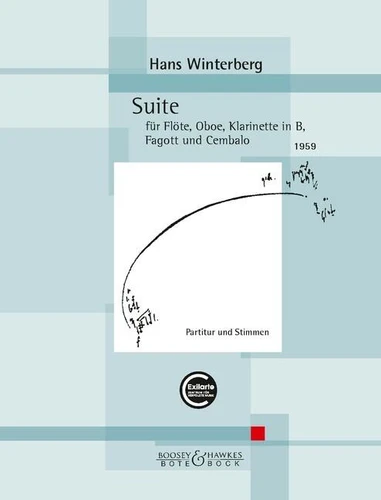Suite für Flöte, Oboe, Klarinette in B, Fagott und Cembalo
Par :Formats :
Actuellement indisponible
Cet article est actuellement indisponible, il ne peut pas être commandé sur notre site pour le moment. Nous vous invitons à vous inscrire à l'alerte disponibilité, vous recevrez un e-mail dès que cet ouvrage sera à nouveau disponible.
- FournisseurSCHOTT MUSIC
- EAN9783793145479
- Réf. fournisseurBB 3850
- Dimensions23,1 cm × 30,3 cm × 0,0 cm
- Poids0.555 kg
- Nb. de pages148
Résumé
Hans Winterberg (1901-1991) left behind a rich chamber music oeuvre, which has only recently been made accessible through first editions and CD productions. In addition to one string trio, four string quartets and two wind quintets for the standard instrumentation of flute, oboe, clarinet, horn and bassoon, his estate contains works in the most diverse and sometimes most unusual combinations of winds, strings and keyboard instruments.
The Suite for flute, oboe, clarinet, bassoon and harpsichord from 1959 was probably written - like many of his other works from the 1950s and 1960s - on commission from Bayerischer Rundfunk, although no traces of performances or broadcasts during the composer's lifetime have been found. As always with Winterberg, the unconventional, humorous and at times surreal handling of the material is surprising, making the Suite seem like an echo of Czech modernism of the interwar period, which Winterberg, who lived in Prague until his emigration to Munich in 1947, had a lasting influence on.
The tonal language is moderately modern : Polytonality, modality, layers of fifths and fourths dominate. The character of the three movements is determined by the tension between the elegant aura of the harpsichord and the rusticity of the wind movement, between post-Janácek folklorism and neoclassical esprit à la Stravinsky. Instrumentation : flute (piccolo), oboe, clarinet in Bb (bass clarinet in Bb) and harpsichord
The Suite for flute, oboe, clarinet, bassoon and harpsichord from 1959 was probably written - like many of his other works from the 1950s and 1960s - on commission from Bayerischer Rundfunk, although no traces of performances or broadcasts during the composer's lifetime have been found. As always with Winterberg, the unconventional, humorous and at times surreal handling of the material is surprising, making the Suite seem like an echo of Czech modernism of the interwar period, which Winterberg, who lived in Prague until his emigration to Munich in 1947, had a lasting influence on.
The tonal language is moderately modern : Polytonality, modality, layers of fifths and fourths dominate. The character of the three movements is determined by the tension between the elegant aura of the harpsichord and the rusticity of the wind movement, between post-Janácek folklorism and neoclassical esprit à la Stravinsky. Instrumentation : flute (piccolo), oboe, clarinet in Bb (bass clarinet in Bb) and harpsichord
Hans Winterberg (1901-1991) left behind a rich chamber music oeuvre, which has only recently been made accessible through first editions and CD productions. In addition to one string trio, four string quartets and two wind quintets for the standard instrumentation of flute, oboe, clarinet, horn and bassoon, his estate contains works in the most diverse and sometimes most unusual combinations of winds, strings and keyboard instruments.
The Suite for flute, oboe, clarinet, bassoon and harpsichord from 1959 was probably written - like many of his other works from the 1950s and 1960s - on commission from Bayerischer Rundfunk, although no traces of performances or broadcasts during the composer's lifetime have been found. As always with Winterberg, the unconventional, humorous and at times surreal handling of the material is surprising, making the Suite seem like an echo of Czech modernism of the interwar period, which Winterberg, who lived in Prague until his emigration to Munich in 1947, had a lasting influence on.
The tonal language is moderately modern : Polytonality, modality, layers of fifths and fourths dominate. The character of the three movements is determined by the tension between the elegant aura of the harpsichord and the rusticity of the wind movement, between post-Janácek folklorism and neoclassical esprit à la Stravinsky. Instrumentation : flute (piccolo), oboe, clarinet in Bb (bass clarinet in Bb) and harpsichord
The Suite for flute, oboe, clarinet, bassoon and harpsichord from 1959 was probably written - like many of his other works from the 1950s and 1960s - on commission from Bayerischer Rundfunk, although no traces of performances or broadcasts during the composer's lifetime have been found. As always with Winterberg, the unconventional, humorous and at times surreal handling of the material is surprising, making the Suite seem like an echo of Czech modernism of the interwar period, which Winterberg, who lived in Prague until his emigration to Munich in 1947, had a lasting influence on.
The tonal language is moderately modern : Polytonality, modality, layers of fifths and fourths dominate. The character of the three movements is determined by the tension between the elegant aura of the harpsichord and the rusticity of the wind movement, between post-Janácek folklorism and neoclassical esprit à la Stravinsky. Instrumentation : flute (piccolo), oboe, clarinet in Bb (bass clarinet in Bb) and harpsichord

